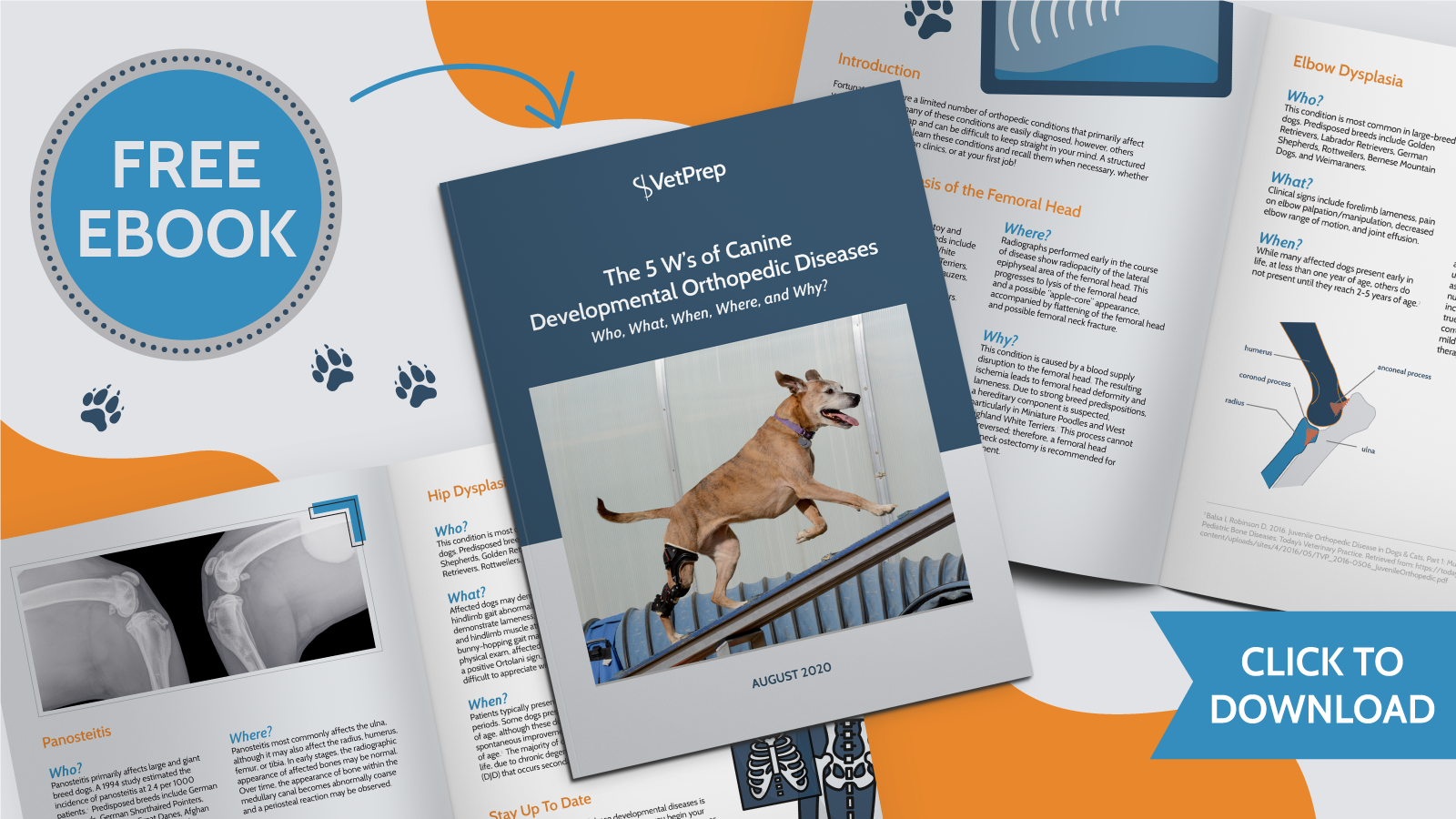
There are two methods commonly used to evaluate the hips of young dogs: PennHip radiographs and the Orthopedic Foundation for Animals (OFA) hip radiographs. Each of these methods has unique pros and cons.
The primary difference between the two methods is that OFA radiographs document anatomic abnormalities and natural laxity, while PennHip radiographs document distractibility under force. This difference in technique also is reflected by differences in sensitivity. A 2010 study found that many dogs judged as clinically normal on OFA radiographs demonstrate laxity on PennHip radiographs, including 52% of dogs with hips that were ranked “excellent” on OFA radiographs.1
This study suggests that PennHip radiographs are more sensitive than OFA hip radiographs, although both methods are still utilized in practice.
PennHip Radiographs
The PennHip technique was developed by Dr. Gail Smith, an orthopedic surgeon from the University of Pennsylvania. For these radiographs, the dog is anesthetized and a total of three images are taken, the most important of which incorporates a uniform force applied to the hips using a distraction device.
Based on PennHip radiographs, a distraction index is calculated. This is done by dividing the measured distance between the femoral head center and the acetabular center by the radius of the femoral head. A distraction index of 0 is the tightest possible reading and a distraction index of 1 represents a fully luxated hip. Dogs with a distraction index of >0.4 are at an increased risk of developing hip dysplasia.
Pros
- PennHip radiographs can be performed on puppies as early as 16 weeks of age.
- The distraction index for a given dog remains static over time, compared to OFA scoring which tends to vary over time.2
- PennHip radiographs, with their calculated distraction index, are more objective than OFA radiographs, which are graded on a subjective scale.
- PennHip radiographs are more sensitive for detecting hip dysplasia than OFA radiographs.
Cons
- In order to perform Pennhip radiographs, the veterinarian and veterinary technician must complete a training program. Although this program is currently free, it is a time commitment.
- The patient must be fully anesthetized to obtain PennHip radiographs.
- Three separate radiographic views are required for interpretation.
- The cost of PennHip radiographs is typically higher than OFA radiographs, due to the need for anesthesia and multiple radiographic views.
OFA Hip Radiographs
Unlike PennHip radiographs, OFA radiographs do not require any specialized training, devices, or positioning. OFA hip radiographs are performed using a standard ventrodorsal view of the pelvis. The dog is placed in dorsal recumbency with the rear limbs extended and parallel to each other, the stifles rotated internally, and the pelvis symmetric. This is a common technique for performing radiographs to evaluate the hips and pelvis.
When the radiographs are evaluated, special attention is given to the: craniolateral acetabular rim, cranial acetabular margin, femoral head, fovea capitis, acetabular notch, caudal acetabular rim, dorsal acetabular margin, junction of femoral head and neck, and trochanteric fossa. After evaluating these regions, the radiologist provides a subjective grade of excellent, good, fair, borderline, or dysplastic (mild, moderate, severe).
Pros
- There is no requirement that the patient be sedated or anesthetized
- No special veterinarian or staff training/certification is required.
- OFA hip radiography requires only a single radiographic view.
- The cost of OFA radiographs is typically lower than PennHip radiographs, because anesthesia is not required and only a single view is needed.
Cons
- Prior to the age of 24 months, only “preliminary consultations” can be performed.
- Although sedation is not technically required, it may be impossible to obtain diagnostic radiographs without sedation.
- OFA grading is less sensitive than PennHip radiographs.
- OFA grading is more subjective than PennHip radiographs; an individual patient’s grade may vary between reviewers and may vary over time.
- OFA grading cannot be performed in pregnant females or females in estrus, due to the effects of hormones on joint laxity.
Summary
Both PennHip and OFA radiographs have their unique pros and cons. While PennHip radiographs are more sensitive for the detection of hip dysplasia, OFA radiographs may be more convenient for the veterinary practice and more affordable for the client. Ultimately, the decision of which radiographs to perform will depend upon the client’s goals and budget.
References
- Powers MY, Karbe GT, Gregor TP, et al. Evaluation of the relationship between Orthopedic Foundation for Animals' hip joint scores and PennHIP distraction index values in dogs. J Am Vet Med Assoc. 2010;237(5):532-541. doi:10.2460/javma.237.5.532
- Smith GK, Gregor TP, Rhodes WH and Biery D. Coxofemoral joint laxity from distraction radiography and its contemporaneous and prospective correlation with laxity, subjective score and evidence of degenerative joint disease from conventional hip-extended radiography, Am J Vet Res. 1993; 54: 1021-1042.



